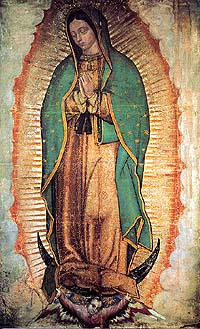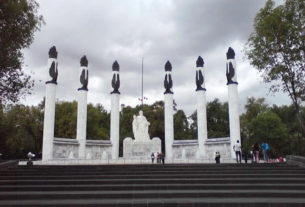No sooner had the Spanish conquistadores vanquished the Aztec Empire militarily, than the spiritual conquest of Indian Mexico began. The Spaniards were devoutly Roman Catholic. It should be remembered that Spain’s rise to power came as a direct result of regaining the Iberian peninsula from Moslem rule. In return for having driven out the Moors, the Pope granted the Spanish Crown authority over the Church within its domain, effectively making the it an arm of the State. Thus, for Carlos V, the conquest of the Americas more than just a quest for territory and material riches. His personal mission as an agent of the Vatican was the ardent pursuit of souls for salvation.
At that time the Church’s organization was divided into two distinct branches. Under the Papal grant of power to the Spanish Crown, the secular clergy was comprised of priests who served under their bishops. The missionary orders, on the other hand, were designated as self-governing bodies under the separate authority of their respective superiors, as decreed by Pope Leon X in 1521. Secular priests were prohibited from interfering with the regular clergy, on penalty of ex-communication. Thus, during Mexico’s colonial era, the secular clergy worked hand in hand with civil authorities, while the missionary friars, laboring independently, tended to have greater influence over the common people.
The first Franciscan missionaries, sent by Carlos V at Cortés request, arrived in Mexico in 1523 and 1524. By 1559 there were 300 Franciscan friars at 80 missions throughout Nueva España. They were followed by the Dominicans (1525), the Augustinians (1533), and finally, the Jesuits (1571). Altogether some 12,000 churches were built during the three centuries of Spanish rule over Mexico.
Although their chief goal was to perform the sacraments and introduce the Indians to the fundamentals of Christian doctrine, in many respects the missionary friars laid the groundwork for the fusion of the Spanish and Mexican cultures. They won the trust of the native population by protecting them from the excesses to which many of the Spanish civilians were inclined. They also took responsibility for the basic education of the Indians, an effort greatly enhanced by their assiduous study of Indian languages. They established schools where youngsters learned to read and write and were introduced to european music and the arts. Adults were trained to practice agriculture and trades, learning European methods in masonry, carpentry, iron work, weaving, dying, and ceramics.
Many Catholic schools in Mexico today bear the name of Fray Pedro de Gante, the first of New Spain’s distinguished missionary educators. The Dominican friar Bartolomé de Las Casas, who rose to become Bishop of Chiapas, was nicknamed “Father of the Indians” for his staunch defense of the Indians’ legal rights. Fray Toribio de Benavente, fondly dubbed Motolinía (meaning “poor one”), was a self-sacrificing man dedicated to protecting the natives. He penned a scholarly treatise entitled Historia de los Indios . Essential knowledge of Aztec life is largely attributed to Fray Bernardino de Sahagún for his richly detailed Historia general de las cosas de Nueva España .
The first archbishop of Mexico, Fray Juan de Zumárraga, was another steadfast advocate for the indigenous people who, in conjunction with Viceroy Antonio de Mendoza, established the renowned Santa Cruz de Tlatelolco school for the sons of Indian nobles. He earned the moniker “Protector of the Indians” after founding of the Santa Fe hospices in Mexico City and Paztcuaro, where aid was dispensed to the poorest of natives. He also set up the first printing press in the Americas.
Since it was customary for Mesoamerican cultures to adopt the religion of conquering tribes, the Indians were not naturally inclined to resist conversion to Christianity. There were in fact certain similarities in doctrines and rituals that facilitated matters. Human sacrifice–a practice the Spaniards found particularly abhorrent–predisposed the Aztecs to readily accept the concept of consuming the body and blood of Christ in the celebration of the Holy Eucharist. Likewise, it was not a stretch for the Indians to substitute adoration of the Virgin Mary for worship of Tonantzin, their mother figure.
Although the church strove to put an end to most pagan practices, some ancient religious customs were assimilated in the celebration of Christians holidays. For example, All Souls Day, November 2nd, closely coincided with the Aztec’s autumn rituals in honor of departed ancestors, giving rise to the unique Day of the Dead festivities still observed in Mexico today.

Our Lady of Guadalupe
Perhaps the most significant religious event of the Colonial period was the apparition of the Virgin Mary (1531) to a newly converted Indian baptized with the name Juan Diego. While walking across Tepeyac, a hill located just north of the capital, he is said to have beheld a resplendent vision of a dark-skinned woman. She entreated him to go to Bishop Zumárraga and request that a temple be built in her honor on the sacred grounds where the Aztecs had worshipped their mother goddess Tonantzin. As evidence of the miraculous appearance, Juan Diego retrieved an armload of roses from the normally barren hillside, gathering them up in his tilma (cotton cloak). When he unleashed the cascade of flowers at the bishop’s feet, he revealed a stunning image of the Virgin imprinted on the cloak. Not unlike the Shroud of Turin, the image of La Virgen de Guadalupe still defies scientific explanation. La Guadalupana, Reina de Mexico (Queen of Mexico), has since become the religious patroness of all Latin Americans.
In the aftermath of the Conquest the Spaniards began to set up Nueva España’s political, social and economic structure. While the Ciudad de Mexico was being erected on the ruins of the old Aztec capital, the remainder of the conquered territory was gradually divvied up into grants for huge estates, known as encomiendas, operated under a feudal system by some 500 Spanish landlords. Under the original scheme, title reverted to the Spanish Crown upon the death of the encomendero (estate owner), but in time heirs were allowed retain rights by inheritance.
The encomendero was entitled to reap whatever benefit he could from the estate, including the unpaid labor of the native inhabitants for working the fields or mines. Theoretically, they were also obliged to look after the physical, intellectual and spiritual well-being of the Indians. With a few exceptions, most exploited their privileges without fulfilling their obligations. Communal village ownership of tillable lands–known as the ejido system–was also established during the early Colonial Period. All of these would become significant factors in subsequent events in Mexico’s history.
In any case, although the encomienda system continued into the 18th century, its importance in the overall economy of New Spain was short-lived. The Spanish soldiers responsible for the conquest of Tenochtitlan–along with thousands of new Spanish adventurers who emigrated in the century following the Conquest–took little interest in working the land, preferring instead to set out northward in search of gold and other riches in the fabled Seven Cities of Cibola. The quest for this mythical land of plenty, probably invented by natives as a ploy to send earlier adventurers onward, ultimately proved fruitless.
As colonial society grew, a well-defined caste system developed. The top stratus was formed by Spaniards born in Spain, called peninsulares or gachupines, most of whom came from titled families and held the highest ranking posts in both the government and the clergy. Next came the criollos, those born in Mexico of Spanish parents. While few of the criollos who came to occupy official positions were able to rise above a secondary level, many others managed to prosper by becoming landowners and merchants . A growing number were able to enjoy lives of leisure thanks to the toil of Indians who turned their farms, ranches, mines and commercial ventures into productive enterprises.
The dearth of Spanish women at the start of the Colonial era led to numerous unions between Indian women and Spaniards. An immediate consequence was the birth of many mixed-blood–mostly illegitimate–offspring. These so-called mestizos made up a rapidly growing socioeconomic class that, for the most part, were considered inferior by pure-blood Spaniards. Mestizos –who today make up the vast majority of Mexico’s population–were to remain poor and uneducated for many generations.
The native Indians were delegated to the next rung down New Spain’s social ladder. Considered wards of the Crown and the Church, the law required that legal authorities, the clergy and the encomenderos protect their welfare. Nonetheless, the Spaniards depended heavily upon native labor. Scarcely looked upon as human beings, hundreds of thousands of Indians were literally worked to death. Others succumbed to new diseases introduced by the Spaniards: smallpox, measles, plague, tuberculosis, and even the common cold. At the time of the Conquest, about nine million indigenous people inhabited Mexico’s central plateau. By 1600 they numbered a scant two and a half million.
The devastation of the Indian population created a significant labor shortage. This situation was remedied by importing thousands of African slaves. (Curiously, slavery of the Indians had been prohibited in the mid-16th century by Nueva España’s second Viceroy, Luis de Velasco.) Although they came at a premium, due to high transportation costs, the Spaniards willingly paid for slaves who seemed to withstand both hard labor and harsh working conditions better than the Indians. With the remuneration received for their steadfast labor, many Blacks were eventually able to purchase their freedom.
Diverse racial subgroups originated in subsequent generations, including mulattos (Spanish-African), castizos (Spanish-Mestizo), zambos (Indian-African). Added to this mix were the large numbers of Filipinos, Chinese and Europeans of assorted nationalities who emigrated to Mexico during the era. Having emerged from this singular fusion, modern Mexican society has garnered the tag la raza cósmica–the cosmic race.



